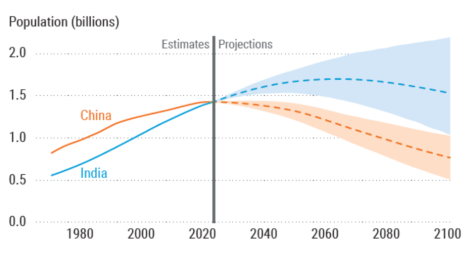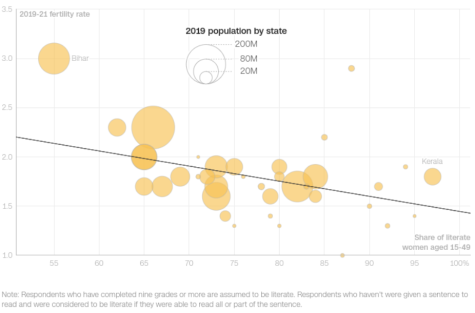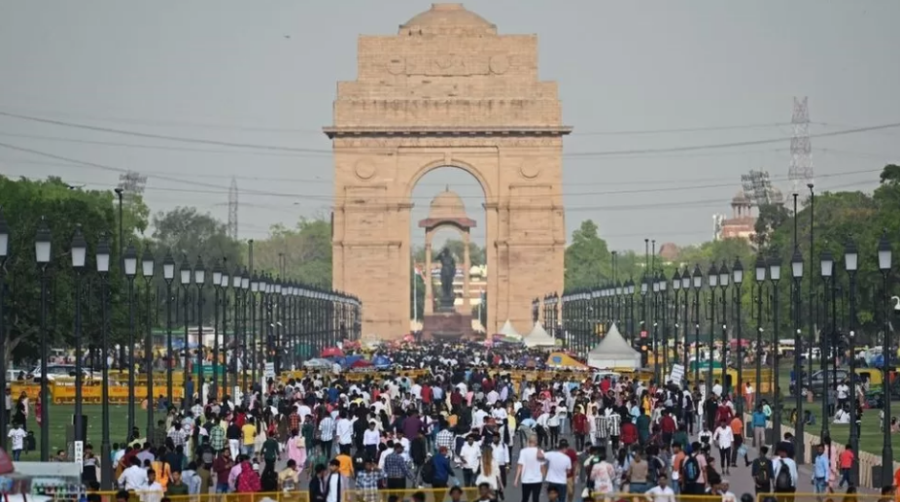UN estimates India will surpass China’s population
The United Nations (UN) predicts India will overtake China as the most populated country.
Although the original estimate expected India to outnumber China with a population of 1.425 billion people by the end of April, as of May 1 the current population places India at 1.418 billion and China at 1.454 billion.
Reasons:
Part of the reason India has the opportunity to overtake China’s population is due to China’s goal to reduce their population.
“Population is important but talents are also important…China has taken active measures to respond to population aging,” said Wang Webin, Chinese Foreign Ministry spokesperson.
With this goal in mind, China implemented anti-natalist efforts such as the promotion of birth control, an emphasis on family planning, and the one-child policy, while also ensuring the preservation of quality workers.

India’s growth in population can also be attributed to its high birth rate.
In 1960 India had a birth rate of six, which is 3.9 above what is necessary for a stable population.
Although the birth rate dropped to two from 2019 to 2021, the population is still expanding.
“When the fertility rate drops, the population continues to grow for several decades. [This] is because younger, large cohorts are still growing into [the] age when they become parents,” said Frank Swalanchy, a researcher for The Federal Institute for Population Research.
Furthermore, with economic and social issues taking the forefront of the country’s attention, family planning initiatives, birth control accessibility, and attempts at sterilizing men have failed to take effect in India.
Concerns:
Although the population growth in India has boosted its overall economy to $3.5 trillion, 7.8 percent of the country remains unemployed due to a lack of job accessibility.
According to Sabina Dewan, a visiting fellow at the Center for Policy Research, the economic benefit which comes along with population growth “hinges on providing good quality, productive, and well-remunerated jobs.
Job insecurity is amplified in northern states, such as Uttar Pradesh, which rely on their agriculture, causing them to lack enough industrial jobs.
India’s large population also causes many to struggle with access to water, food, and sanitation.
For example, 194.4 million people within India are malnourished, overall dampening the health of the country.
India’s population trends:
Despite the large population, compared to its original growth rate of 2.2 percent in the 1970s and 1980s, it has since slowed down to 1.5 percent in the 21st century.
Researchers found when looking at demographics, northern states had comparatively higher fertility rates than the south.
Barbara Seligman, senior vice president at Population Reference Bureau (PRB), said that the state with the highest fertility rate is Bihar, with a score of three. She also expressed how northern states such as Bihar, Meghalaya, Uttar Pradesh, and Manipur were also at that level.
Conversely, south Indian states like Goa, are experiencing an aging population, which is when at least seven percent of the population is older than 65.

India Demographic and Health Survey also found a link between women’s literacy and fertility rates.
In Bihar, the women’s literacy rate is at 55 percent, and the fertility rate is at three kids per woman.
On the other hand, in the southern state of Kerala, the woman’s literacy rate is at 97 percent, and the fertility rate is at 2.1 kids per woman.
Solutions:
Based on these trends, Poonam Muttreja, executive director of the Population Foundation of India, argues educating Indian women would be effective in giving them the opportunity to work which would in turn lower birth rates and help reduce the lack of employment.
Another possible solution was expressed by Javaid Iqbal, a Global Fellow at Brandeis University, who wrote that India should invest in its contraceptives as they are only used by 56 percent of the Indian population.
“In 21st-century India, the ability to fulfill dreams starts with a person, starts with a family. If the population is not educated, not healthy, then neither the home nor the country can be happy,” said India Prime Minister, Narendra Modi.






